PONTIAC FIERO 1988 Service Repair Manual
Manufacturer: PONTIAC, Model Year: 1988, Model line: FIERO, Model: PONTIAC FIERO 1988Pages: 1825, PDF Size: 99.44 MB
Page 261 of 1825
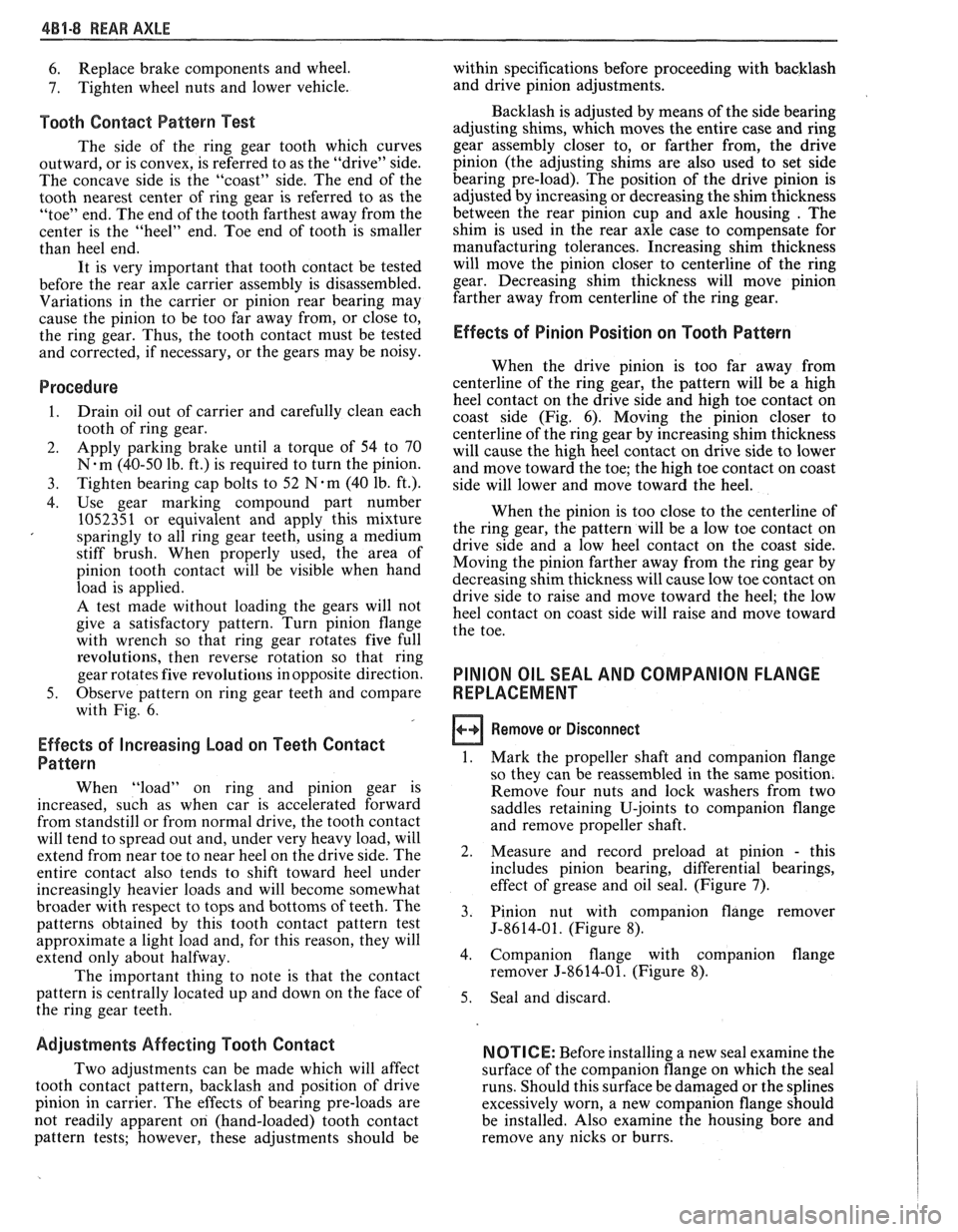
481.8 REAR AXLE
6. Replace
brake components and wheel.
7. Tighten wheel nuts and lower vehicle.
Tooth Contact Pattern Test
The side of the ring gear tooth which curves
outward, or is convex, is referred to as the "drive" side.
The concave side is the "coast" side. The end of the
tooth nearest center of ring gear is referred to as the
"toe" end. The end of the tooth farthest away from the
center is the "heel" end. Toe end of tooth is smaller
than heel end.
It is very important that tooth contact be tested
before the rear axle carrier assembly is disassembled.
Variations in the carrier or pinion rear bearing may
cause the pinion to be too far away from, or close to,
the ring gear. Thus, the tooth contact must be tested
and corrected, if necessary, or the gears may be noisy.
Procedure
1. Drain
oil out of carrier and carefully clean each
tooth of ring gear.
2. Apply parking brake until a torque of 54 to 70
N-m (40-50 lb. ft.) is required to turn the pinion.
3. Tighten bearing cap bolts to 52 N-m (40 lb. ft.).
4. Use gear marking compound part number
1052351 or equivalent and apply this mixture
sparingly to all ring gear teeth, using a medium
stiff brush. When properly used, the area of
pinion tooth contact will be visible when hand
load is applied.
A test made without loading the gears will not
give a satisfactory pattern. Turn pinion flange
with wrench so that ring gear rotates five full
revolutions, then reverse rotation so that ring
gear rotates five
revolutio~ls in opposite direction.
5. Observe pattern on ring gear teeth and compare
with Fig.
6.
Effects of Increasing Load on Teeth Contact
Pattern
When "load" on ring and pinion gear is
increased, such as when car is accelerated forward
from standstill or from normal drive, the tooth contact
will tend to spread out and, under very heavy load, will
extend from near toe to near heel on the drive side. The
entire contact also tends to shift toward heel under
increasingly heavier loads and will become somewhat
broader with respect to tops and bottoms of teeth. The
patterns obtained by this tooth contact pattern test
approximate a light load and, for this reason, they will
extend only about halfway.
The important thing to note is that the contact
pattern is centrally located up and down on the face of
the ring gear teeth.
Adjustments Affecting Tooth Contact
Two adjustments can be made which will affect
tooth contact pattern, backlash and position of drive
pinion in carrier. The effects of bearing pre-loads are
not readily apparent
on (hand-loaded) tooth contact
pattern tests; however, these adjustments should be within
specifications before proceeding with backlash
and drive pinion adjustments.
Backlash is adjusted by means of the side bearing
adjusting shims, which moves the entire case and ring
gear assembly closer to, or farther from, the drive
pinion (the adjusting shims are also used to set side
bearing pre-load). The position of the drive pinion is
adjusted by increasing or decreasing the shim thickness
between the rear pinion cup and axle housing
. The
shim is used in the rear axle case to compensate for
manufacturing tolerances. Increasing shim thickness
will move the pinion closer to centerline of the ring
gear. Decreasing shim thickness will move pinion
farther away from centerline of the ring gear.
Effects of Pinion Position on Tooth Pattern
When the drive pinion is too far away from
centerline of the ring gear, the pattern will be a high
heel contact on the drive side and high toe contact on
coast side (Fig. 6). Moving the pinion closer to
centerline of the ring gear by increasing shim thickness
will cause the high heel contact on drive side to lower
and move toward the toe; the high toe contact on coast
side will lower and move toward the heel.
When the pinion is too close to the centerline of
the ring gear, the pattern will be a low toe contact on
drive side and a low heel contact on the coast side.
Moving the pinion farther away from the ring gear by
decreasing shim thickness will cause low toe contact on
drive side to raise and move toward the heel; the low
heel contact on coast side will raise and move toward
the toe.
PINION OIL SEAL AND COMPANION FLANGE
REPLACEMENT
Remove or Disconnect
1. Mark the propeller shaft and companion flange
so they can be reassembled in the same position.
Remove four nuts and lock washers from two
saddles retaining
U-joints to companion flange
and remove propeller shaft.
2. Measure and record preload at pinion - this
includes pinion bearing, differential bearings,
effect of grease and oil seal. (Figure
7).
3. Pinion nut with companion flange remover
J-8614-01. (Figure 8).
4. Companion flange with companion flange
remover
5-8614-01. (Figure 8).
5. Seal and discard.
NOTICE: Before installing a new seal examine the
surface of the companion flange on which the seal
runs. Should this surface be damaged or the splines
excessively worn, a new companion flange should
be installed. Also examine the housing bore and
remove any nicks or burrs.
Page 262 of 1825
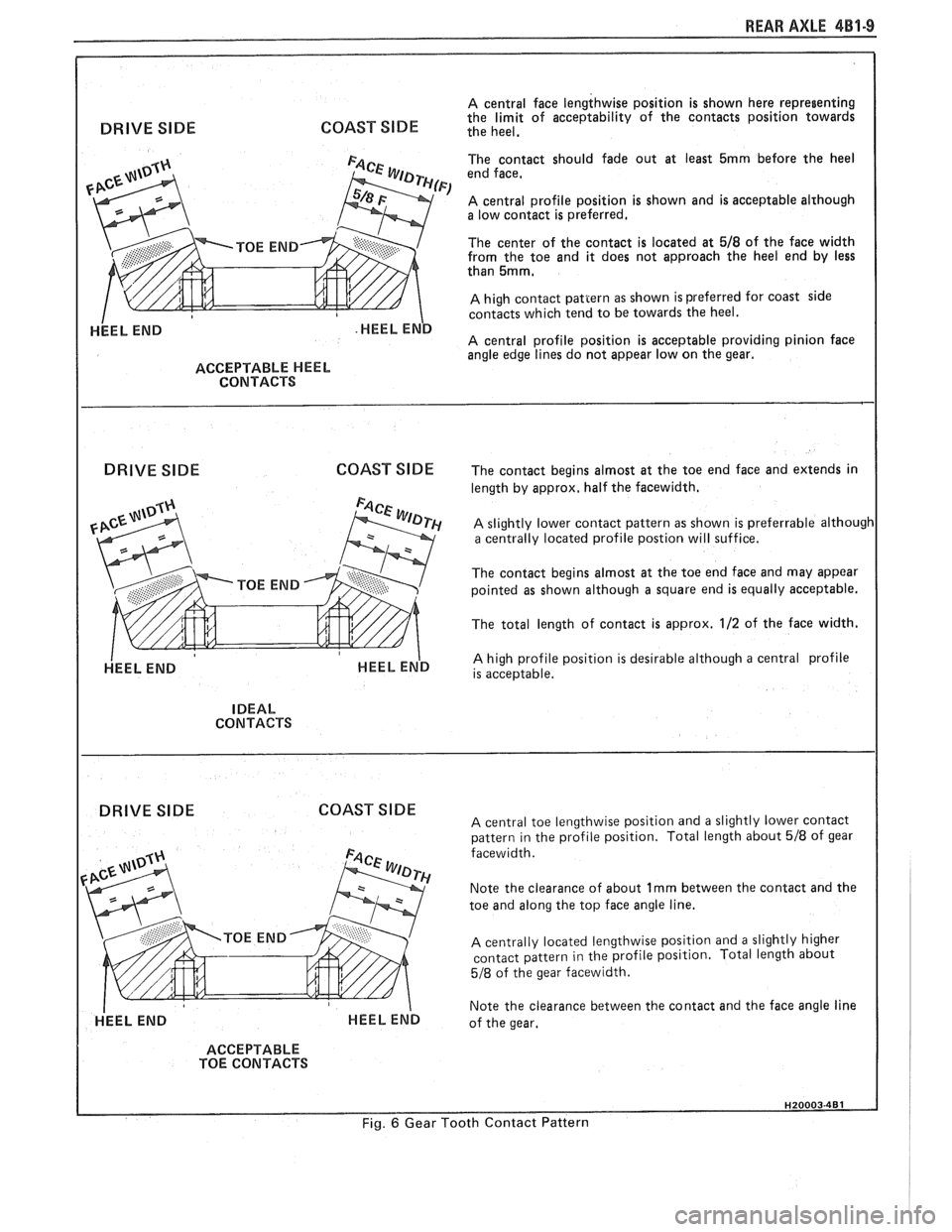
REAR AXLE 481-9
A central face lengthwise position is shown here representing
COAST SlDE the limit of acceptability of the contacts position towards DRIVE SIDE the heel.
ACCEPTABLE HEEL
CONTACTS
DRIVE SlDE COAST
SlDE
HEEL END
The contact should fade out at least 5mrn before the heel
end face,
A central profile position is shown and is acceptable alrhough a low contact is preferred.
The center of the contact is located at
518 of the face width
from the toe and it does not approach the heel end by less
than
5mm,
A high contact pattern as shown is preferred for coast side
contacts which tend to be towards the heel.
A central profile position is acceptable providing pinion face
angle edge lines do not appear low on the gear.
The contact begins almost at the toe end face and extends in
length by approx, half the facewidth.
A slightly lower contact pattern as shown is preferrable although a centrally located profile postion will suffice.
The contact begins almost at the toe end face and may appear
pointed as shown although a square end is equally acceptable.
The total length of contact is approx.
112 of the face width.
A high profile position is desirable although a central profile
is acceptable.
IDEAL
CONTACTS
DRIVE SIDE COAST SIDE A central toe lengthwise position and a slightly lower contact
pattern in the profile position. Total length about 518 of gear
facewidth.
Note the clearance of about
1 rnrn between the contact and the
toe and along the top face angle line.
A centrally located lengthwise position and a slightly higher
contact pattern in the profile position. Total length about
518 of the gear facewidth.
Note the clearance between the contact and the face angle line
of the gear.
ACCEPTABLE
TOE CONTACTS
Fig. 6 Gear Tooth Contact Pattern
Page 263 of 1825
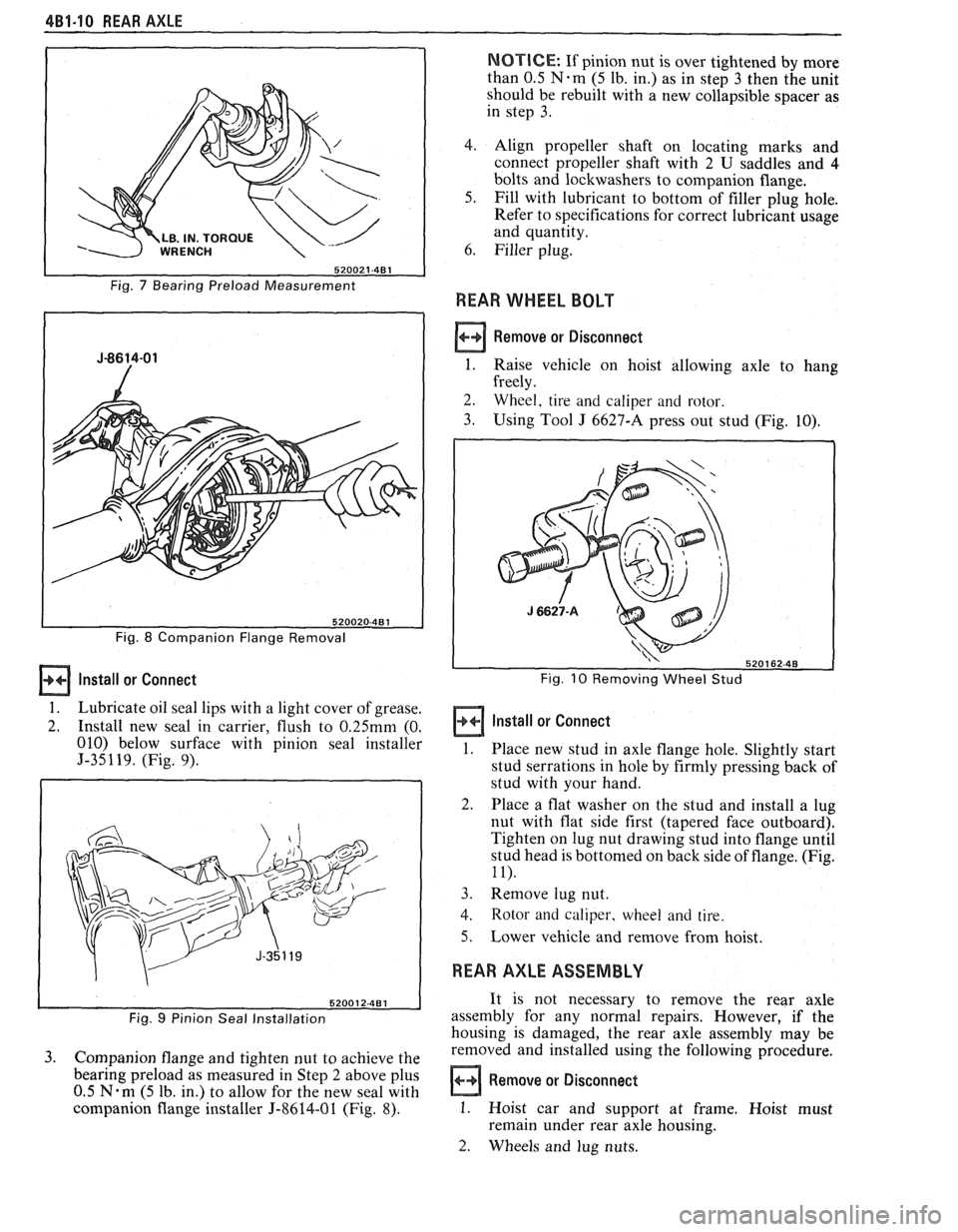
481-10 REAR AXLE
LB. IN. TORQU
520021-481
Fig. 7 Bearing Preload Measurement
Fig.
8 Companion Flange Removal
Install or Connect
1. Lubricate oil seal lips with a light cover of grease.
2. Install
new seal in carrier, flush to
0.25mm (0.
010) below surface with pinion seal installer
5-351 19. (Fig. 9).
Fig. 9 Pinion Seal Installation
3. Companion flange and tighten nut to achieve the
bearing preload as measured in Step
2 above plus
0.5
N-m (5 lb. in.) to allow for the new seal with
companion flange installer J-86 14-0 1 (Fig.
8).
NOTICE: If pinion nut is over tightened by more
than 0.5
N.m (5 lb. in.) as in step 3 then the unit
should be rebuilt with a new collapsible spacer as
in step 3.
4. Align propeller shaft on locating marks and
connect propeller shaft with 2
U saddles and 4
bolts and lockwashers to companion flange.
5. Fill with lubricant to bottom of filler plug hole.
Refer to specifications for correct lubricant usage
and quantity.
6. Filler plug.
REAR WHEEL BOLT
Remove or Disconnect
1.
Raise vehicle on hoist allowing axle to hang
freely.
2. Wheel, tire and caliper and rotor.
3. Using Tool J 6627-A press out stud (Fig. 10).
Fig. 10 Removing Wheel Stud
I Install or Connect
1. Place new stud in axle flange hole. Slightly start
stud serrations in hole by firmly pressing back of
stud with your hand.
2. Place a flat washer on the stud and install a lug
nut with flat side first (tapered face outboard).
Tighten on lug nut drawing stud into flange until
stud head is bottomed on back side of flange. (Fig.
11).
3. Remove lug nut.
4. Rotor and caliper, wheel and tire.
5. Lower vehicle and remove from hoist.
REAR AXLE ASSEMBLY
It is not necessary to remove the rear axle
assembly for any normal repairs. However, if the
housing is damaged, the rear axle assembly may be
removed and installed using the following procedure.
I Remove or Disconnect .I
1. Hoist car and support at frame. Hoist must
remain under rear axle housing.
2. Wheels and lug nuts.
Page 264 of 1825
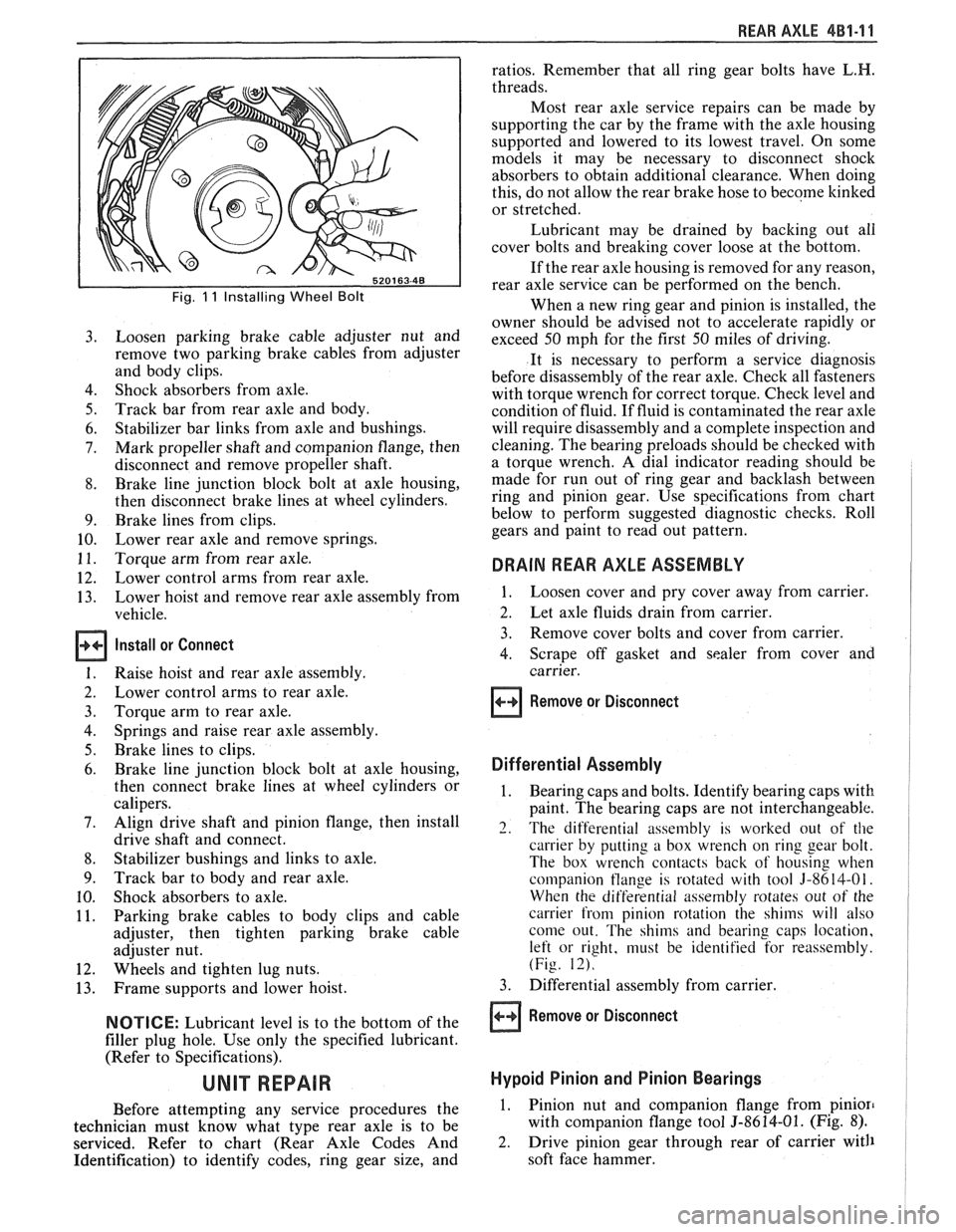
REAR AXLE 4Bl-I I
Fig. 11 Installing Wheel Bolt
Loosen parking brake cable adjuster nut and
remove two parking brake cables from adjuster
and body clips.
Shock absorbers from axle.
Track bar from rear axle and body.
Stabilizer bar links from axle and bushings.
Mark propeller shaft and companion flange, then
disconnect and remove propeller shaft.
Brake line junction block bolt at axle housing,
then disconnect brake lines at wheel cylinders.
Brake lines from clips.
Lower rear axle and remove springs.
Torque arm from rear axle.
Lower control arms from rear axle.
Lower hoist and remove rear axle assembly from
vehicle.
Install or Connect
Raise hoist and rear axle assembly.
Lower control arms to rear axle.
Torque arm to rear axle.
Springs and raise rear axle assembly.
Brake lines to clips.
Brake line junction block bolt at axle housing,
then connect brake lines at wheel cylinders or
calipers.
Align drive shaft and pinion flange, then install
drive shaft and connect.
Stabilizer bushings and links to axle.
Track bar to body and rear axle.
Shock absorbers to axle.
Parking brake cables to body clips and cable
adjuster, then tighten parking brake cable
adjuster nut.
Wheels and tighten lug nuts.
Frame supports and lower hoist.
NOTICE: Lubricant level is to the bottom of the
filler plug hole. Use only the specified lubricant.
(Refer to Specifications).
Before attempting any service procedures the
technician must know what type rear axle is to be
serviced. Refer to chart (Rear Axle Codes And
Identification) to identify codes, ring gear size, and ratios.
Remember that all ring gear bolts have
L.H.
threads.
Most rear axle service repairs can be made by
supporting the car by the frame with the axle housing
supported and lowered to its lowest travel. On some
models it may be necessary to disconnect shock
absorbers to obtain additional clearance. When doing
this, do not allow the rear brake hose to become
kinked
or stretched.
Lubricant may be drained by backing out all
cover bolts and breaking cover loose at the bottom.
If the rear axle housing is removed for any reason,
rear axle service can be performed on the bench.
When a new ring gear and pinion is installed, the
owner should be advised not to accelerate rapidly or
exceed 50 mph for the first 50 miles of driving.
It is necessary to perform a service diagnosis
before disassembly of the rear axle. Check all fasteners
with torque wrench for correct torque. Check level and
condition of fluid.
If fluid is contaminated the rear axle
will require disassembly and a complete inspection and
cleaning. The bearing preloads should be checked with
a torque wrench. A dial indicator reading should be
made for run out of ring gear and backlash between
ring and pinion gear. Use specifications from chart
below to perform suggested diagnostic checks. Roll
gears and paint to read out pattern.
DRAIN REAR AXLE ASSEMBLY
1. Loosen cover and pry cover away from carrier.
2. Let axle fluids drain from carrier.
3. Remove cover bolts and cover from carrier.
4. Scrape off gasket and sealer from cover and
carrier.
Remove or Disconnect
Differential Assembly
1. Bearing caps and bolts. Identify bearing caps with
paint. The bearing caps are not interchangeable.
2. The differential assembly is worked out of the
carrier by putting a box wrench on ring gear bolt.
The box wrench contacts back of housing when
companion
tlange is rotated with tool 3-8614-01.
When the differential assembly rotates out of the
carrier from pinion rotation the shims will also
come out. The shims and bearing caps location,
left or right, must be identified for reassembly.
(Fig. 12).
3. Differential assembly from carrier.
Remove or Disconnect
Hypoid Pinion and Pinion Bearings
1. Pinion nut and companion flange from pinion
with companion flange tool 5-8614-01. (Fig. 8).
2. Drive pinion gear through rear of carrier with
soft face hammer.
Page 265 of 1825
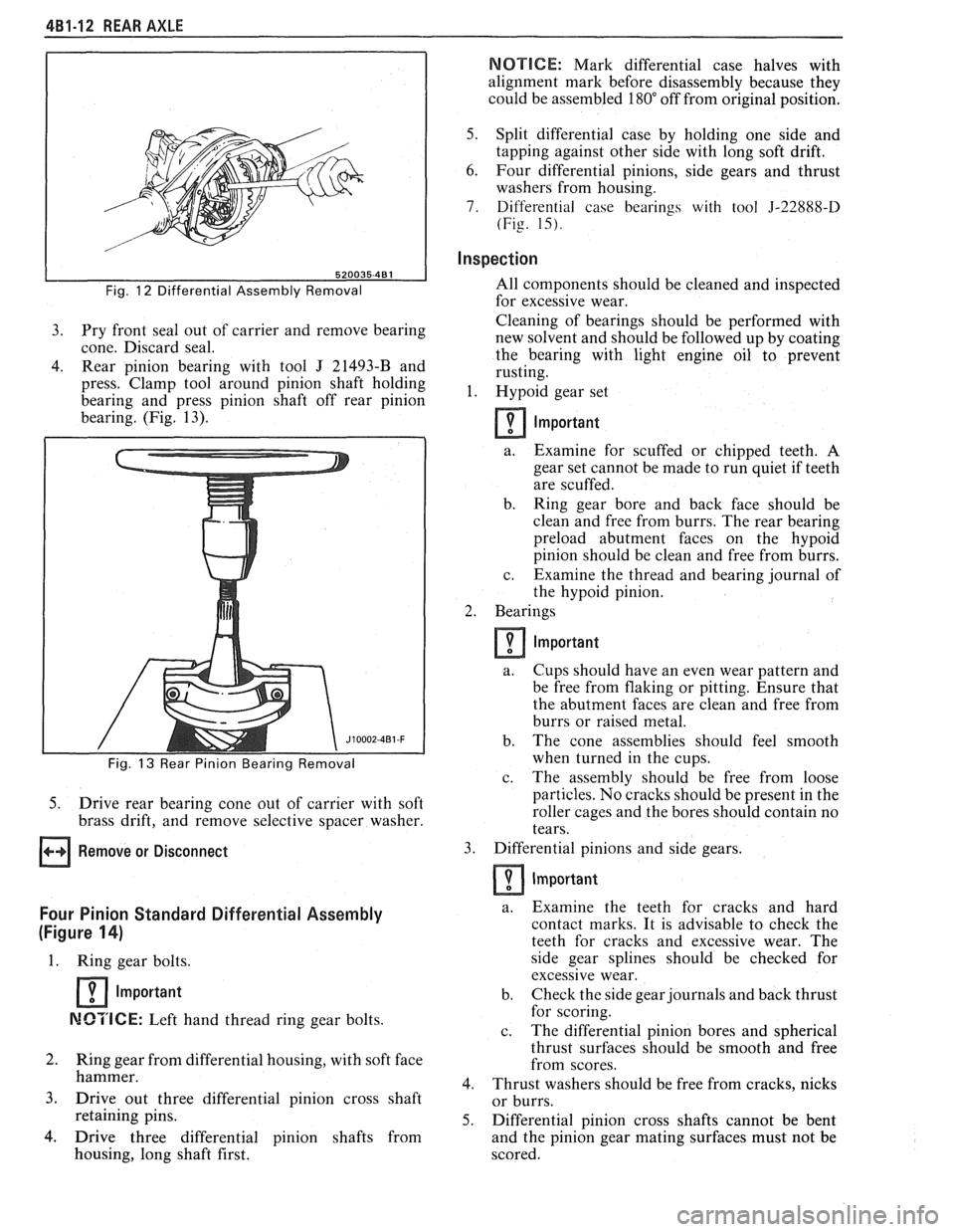
4B1-12 REAR AXLE
NOTICE: Mark differential case halves with
alignment mark before disassembly because they
could be assembled
180" off from original position.
Fig. 12 Differential Assembly Removal
3. Pry front seal out of carrier and remove bearing
cone. Discard seal.
4. Rear pinion bearing with tool J 21493-B and
press. Clamp tool around pinion shaft holding
bearing and press pinion shaft off rear pinion
bearing. (Fig. 13).
I
5. Drive rear bearing cone out of carrier with soft
brass drift, and remove selective spacer washer.
Remove or Disconnect
Four Pinion Standard Differential Assembly
(Figure
14)
1. Ring gear bolts.
1 Important
MCTICE: Left hand thread ring gear bolts.
2. Ring gear from differential housing, with soft face
hammer.
3. Drive out three differential pinion cross shaft
retaining pins.
4. Drive three differential pinion shafts from
housing, long shaft first.
5. Split differential case by holding one side and
tapping against other side with long soft drift.
6. Four differential pinions, side gears and thrust
washers from housing.
7. Differential case bearings with tool 5-22888-D
(Fig. 15).
Inspection
All components should be cleaned and inspected
for excessive wear.
Cleaning of bearings should be performed with
new solvent and should be followed up by coating
the bearing with light engine oil
to prevent
rusting.
1. I-Iypoid gear set
Important
a.
Examine for scuffed or chipped teeth. A
gear set cannot be made to run quiet if teeth
are scuffed.
b. Ring gear bore and back face should be
clean and free from burrs. The rear bearing
preload abutment faces on the
hypoid
pinion should be clean and free from burrs.
c. Examine the thread and bearing journal of
the
hypoid pinion.
2. Bearings
Important
a. Cups should have an even wear pattern and
be free from flaking or pitting. Ensure that
the abutment faces are clean and free from
burrs or raised metal.
b. The cone assemblies should feel smooth
when turned in the cups.
c. The assembly should be free from loose
particles. No cracks should be present in the
roller cages and the bores should contain no
tears.
3. Differential pinions and side gears.
Important
a. Examine the teeth for cracks and hard
contact marks. It is advisable to check the
teeth for cracks and excessive wear. The
side gear splines should be checked for
excessive wear.
b. Check the side gear journals and back thrust
for scoring.
c. The
differential pinion bores and spherical
thrust surfaces should be smooth and free
from scores.
4. Thrust washers should be free from cracks, nicks
or burrs.
5. Differential pinion cross shafts cannot be bent
and the pinion gear mating surfaces must not be
scored.
Page 266 of 1825
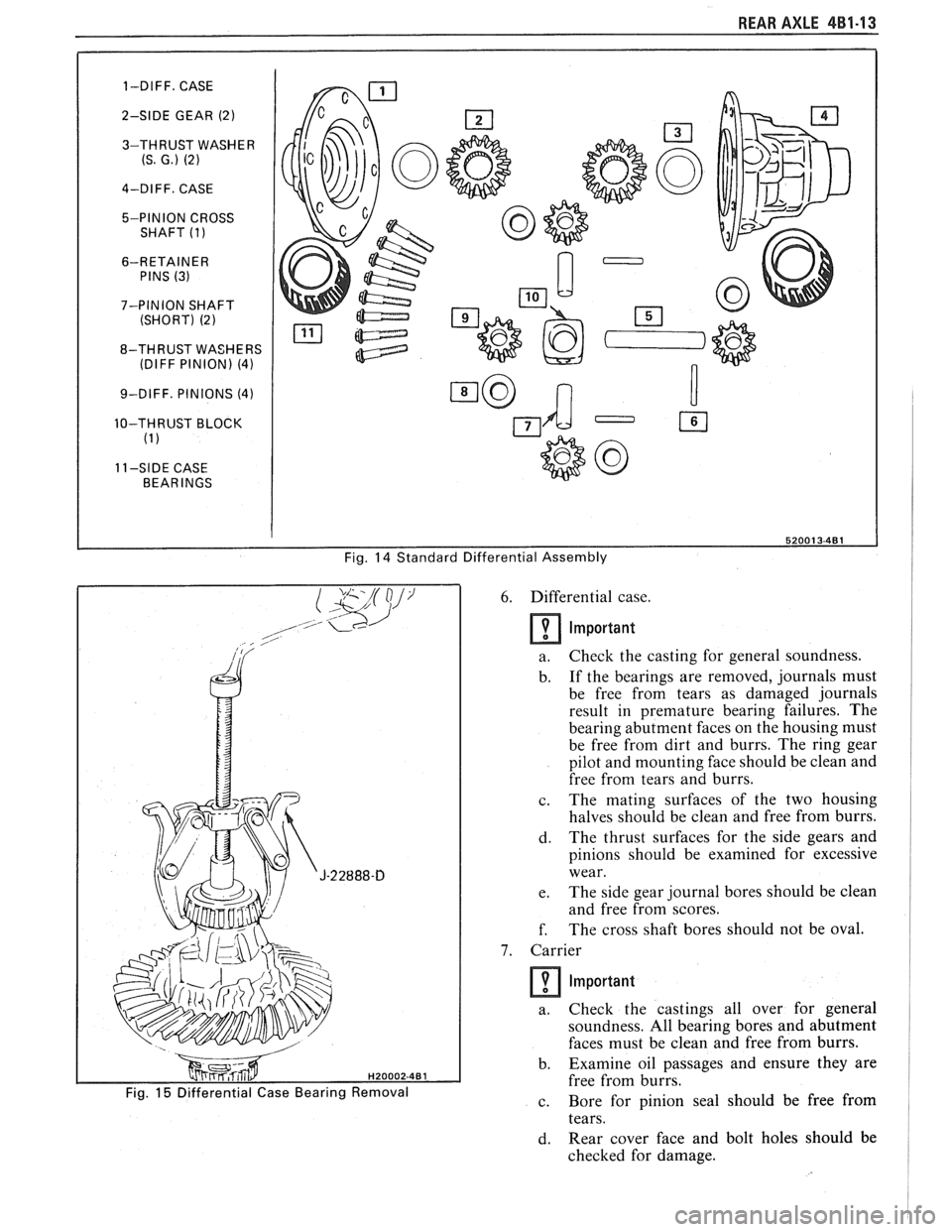
REAR AXLE 4B1-13
1-DIFF. CASE
2-SIDE GEAR
(2)
3-THRUST WASHER (S. G.) (2)
4-DIFF. CASE
5-PINION CROSS
SHAFT
(1)
6-RETAINER PINS (3)
7-PINION SHAFT
(SHORT) (2)
8-THRUST WASHERS (DIFF PINION) (4)
9-DIFF. PINIONS (4)
10-THRUST BLOCK
(1) I
11-SIDE CASE
BEARINGS
I 52001 3-481
Fig. 14 Standard Differential Assembly
6. Differential case.
lmportant
a. Check
the casting for general soundness.
b. If
the bearings are removed, journals must
be free from tears as damaged journals
result in premature bearing failures. The
bearing abutment faces on the housing must
be free from dirt and burrs. The ring gear
pilot and mounting face should be clean and
free from tears and burrs.
c. The
mating surfaces of the two housing
halves should be clean and free from burrs.
d. The
thrust surfaces for the side gears and
pinions should be examined for excessive
wear.
e. The
side gear journal bores should be clean
and free from scores.
f. The cross shaft bores should not be oval.
7. Carrier
lmportant
a. Check
the castings all over for general
soundness. All bearing bores and abutment
faces must be clean and free from burrs.
b. Examine
oil passages and ensure they are
free from burrs.
c. Bore for
pinion seal should be free from
tears.
d. Rear
cover face and bolt holes should be
checked for damage.
Page 267 of 1825
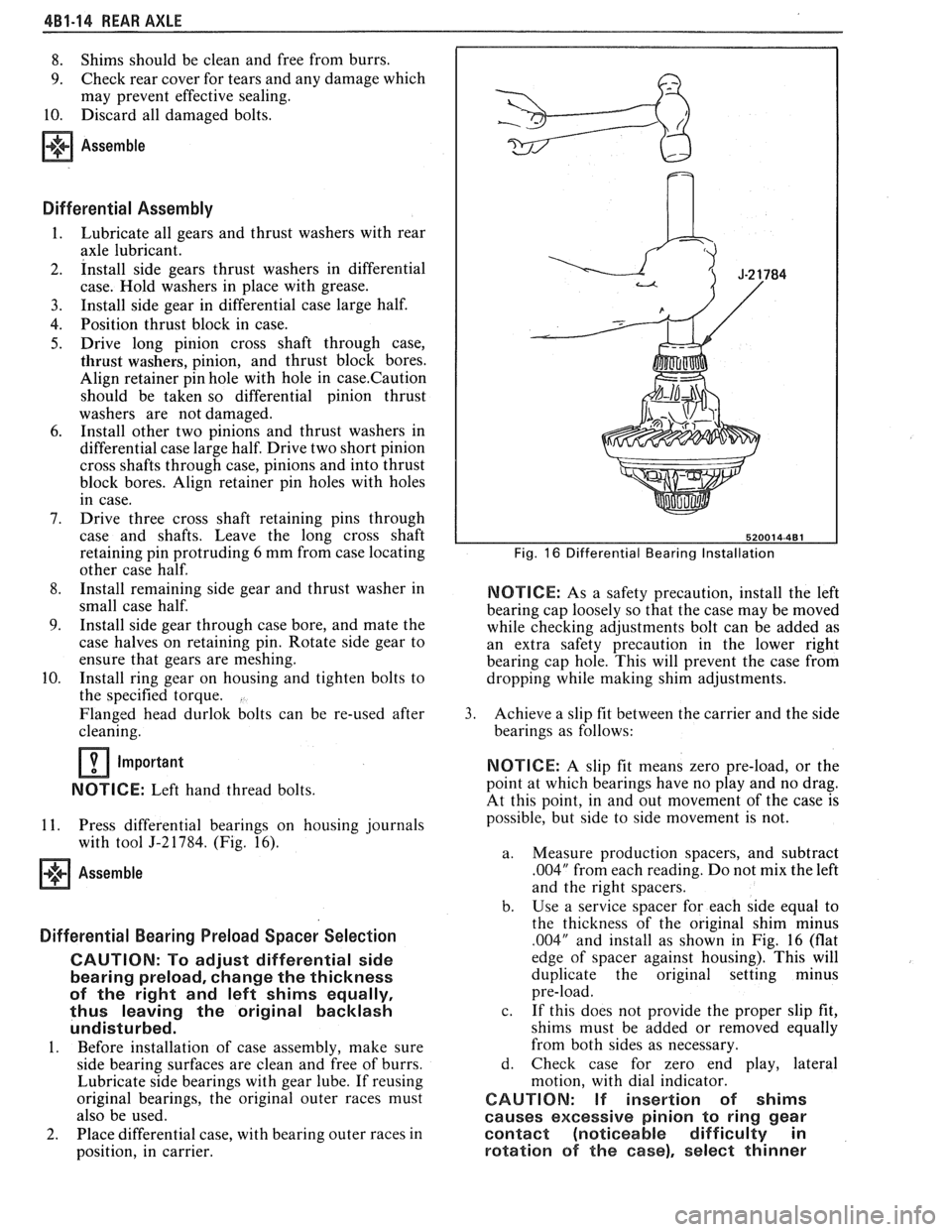
4B1-14 REAR AXLE
8. Shims should be clean and free from burrs.
9. Check rear cover for tears and any damage which
may prevent effective sealing.
10. Discard all damaged bolts.
Assemble
Differential Assembly
Lubricate all gears and thrust washers with rear
axle lubricant.
Install side gears thrust washers in differential
case. Hold washers in place with grease.
Install side gear in differential case large half.
Position thrust block in case.
Drive long pinion cross shaft through case,
thrust washers, pinion, and thrust block bores.
Align retainer pin hole with hole in
case.Caution
should be taken so differential pinion thrust
washers are not damaged.
Install other two pinions and thrust washers in
differential case large half. Drive two short pinion
cross shafts through case, pinions and into thrust
block bores. Align retainer pin holes with holes
in case.
Drive three cross shaft retaining pins through
case and shafts. Leave the long cross shaft
retaining pin protruding 6 mm from case locating
other case half.
Install remaining side gear and thrust washer in
small case half.
Install side gear through case bore, and mate the
case halves on retaining pin. Rotate side gear to
ensure that gears are meshing.
Install ring gear on housing and tighten bolts to
the specified torque.
Flanged head durlok bolts can be re-used after
cleaning.
Important
NOTICE: Left hand thread bolts.
11. Press differential bearings on housing journals
with tool
5-2 1784. (Fig. 16).
Assemble
Differential Bearing Preload Spacer Selection
CAUTION: Po adjust differential side
bearing preload, change the thickness
of the right and left shims equally,
thus leaving the original backlash
undisturbed.
1. Before installation of case assembly, make sure
side bearing surfaces are clean and free of burrs.
Lubricate side bearings with gear lube. If reusing
original bearings, the original outer races must
also be used.
2. Place differential case, with bearing outer races in
position, in carrier.
Fig. 16 Differential Bearing Installation
NOTICE: As a safety precaution, install the left
bearing cap loosely so that the case may be moved
while checking adjustments bolt can be added as
an extra safety precaution in the lower right
bearing cap hole. This will prevent the case from
dropping
while making shim adjustments.
3. Achieve a slip fit between the carrier and the side
bearings as follows:
NOTICE: A slip fit means zero pre-load, or the
point at which bearings have no play and no drag.
At this point, in and out movement of the case is
possible, but side to side movement is not.
a. Measure production spacers, and subtract
.004" from each reading. Do not mix the left
and the right spacers.
b. Use
a service spacer for each side equal to
the thickness of the original shim minus
.004" and install as shown in Fig. 16 (flat
edge of spacer against housing). This will
duplicate the original setting minus
pre-load.
c. If this does not provide the proper slip fit,
shims must be added or removed equally
from both sides as necessary.
d. Check case for zero end play, lateral
motion, with dial indicator.
CAUTION: If insertion of shims
causes excessive pinion to ring gear
contact (noticeable difficulty in
rotation of the case), select thinner
Page 268 of 1825
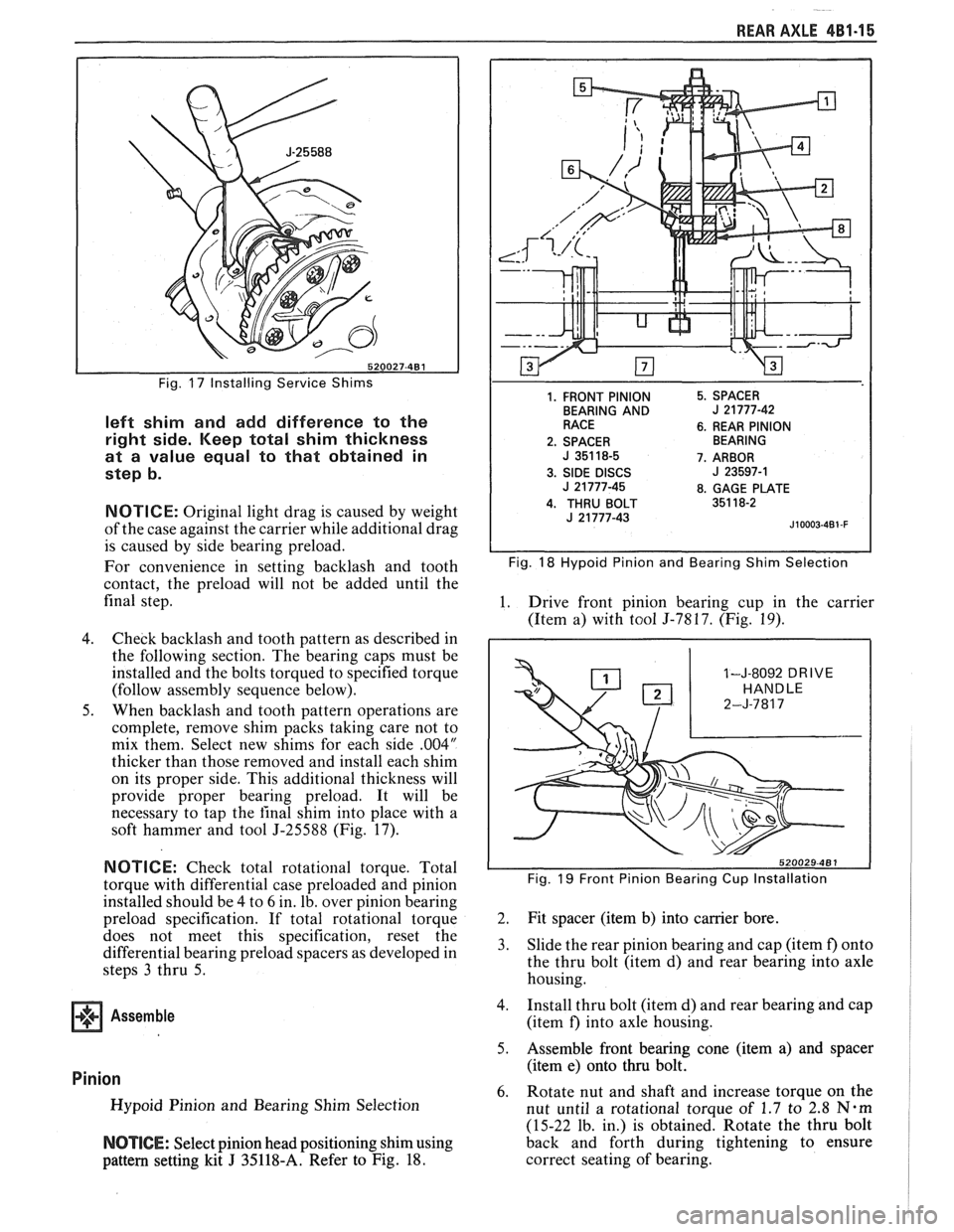
REAR AXLE 481-1 5
Fig. 17 Installing Service Shims
left shim and add difference to the
right side. Keep total shim thickness
at a value equal to that obtained in
step b.
NOTICE: Original light drag is caused by weight
of the case against the carrier while additional drag
is caused by side bearing preload.
For convenience in setting backlash and tooth
contact, the preload will not be added until the
final step.
4. Check backlash and tooth pattern as described in
the following section. The bearing caps must be
installed and the bolts torqued to specified torque
(follow assembly sequence below).
5. When backlash and tooth pattern operations are
complete, remove shim packs taking care not to
mix them. Select new shims for each side
.004"
thicker than those removed and install each shim
on its proper side. This additional thickness will
provide proper bearing preload. It will be
necessary to tap the
final shim into place with a
soft hammer and tool
5-25588 (Fig. 17).
1. FRONT PINION
BEARING AND
RACE
2. SPACER
J 351 18-5
3.
SIDE DISCS J 21 777-45
4. THRU BOLT J 21 777-43 5.
SPACER
J 21777-42
6. REAR PINION
BEARING
7. ARBOR
J 23597-1
8. GAGE PLATE
351 18-2
J10003-4B1 -F
Fig. 18 Hypoid Pinion and Bearing Shim Selection
1. Drive front pinion bearing cup in the carrier
(Item a) with tool
5-7817. (Fig. 19).
1-J-8092 DRIVE
NOTICE: Check total rotational torque. Total
torque with differential case preloaded and pinion Fig. 19 Front Pinion Bearing Cup Installation
installed should be 4 to 6 in. lb, over pinion bearing
preload specification. If total rotational torque 2. Fit spacer (item
b) into carrier bore.
does
not- meet this specification, reset the
differential bearing preload spacers as developed in 3. Slide the rear pinion bearing and cap (item f) onto
steps
3 thru 5. the
thru bolt (item d) and rear bearing into axle
housing.
Assemble 4. Install thru bolt (item d) and rear bearing and cap
(item
f) into axle housing.
5. Assemble front bearing cone (item a) and spacer
(item e) onto thru bolt.
Pinion 6. Rotate nut and shaft and increase torque on the Hypoid Pinion and Bearing Shim Selection
nut until a rotational toraue of 1.7 to 2.8 N-m
(15-22 lb. in.) is obtained: Rotate the thru bolt
NOTICE: Select pinion head positioning shim using back
and forth during tightening to ensure
pattern setting kit
J 35118-A. Refer to Fig. 18. correct
seating of bearing.
Page 269 of 1825
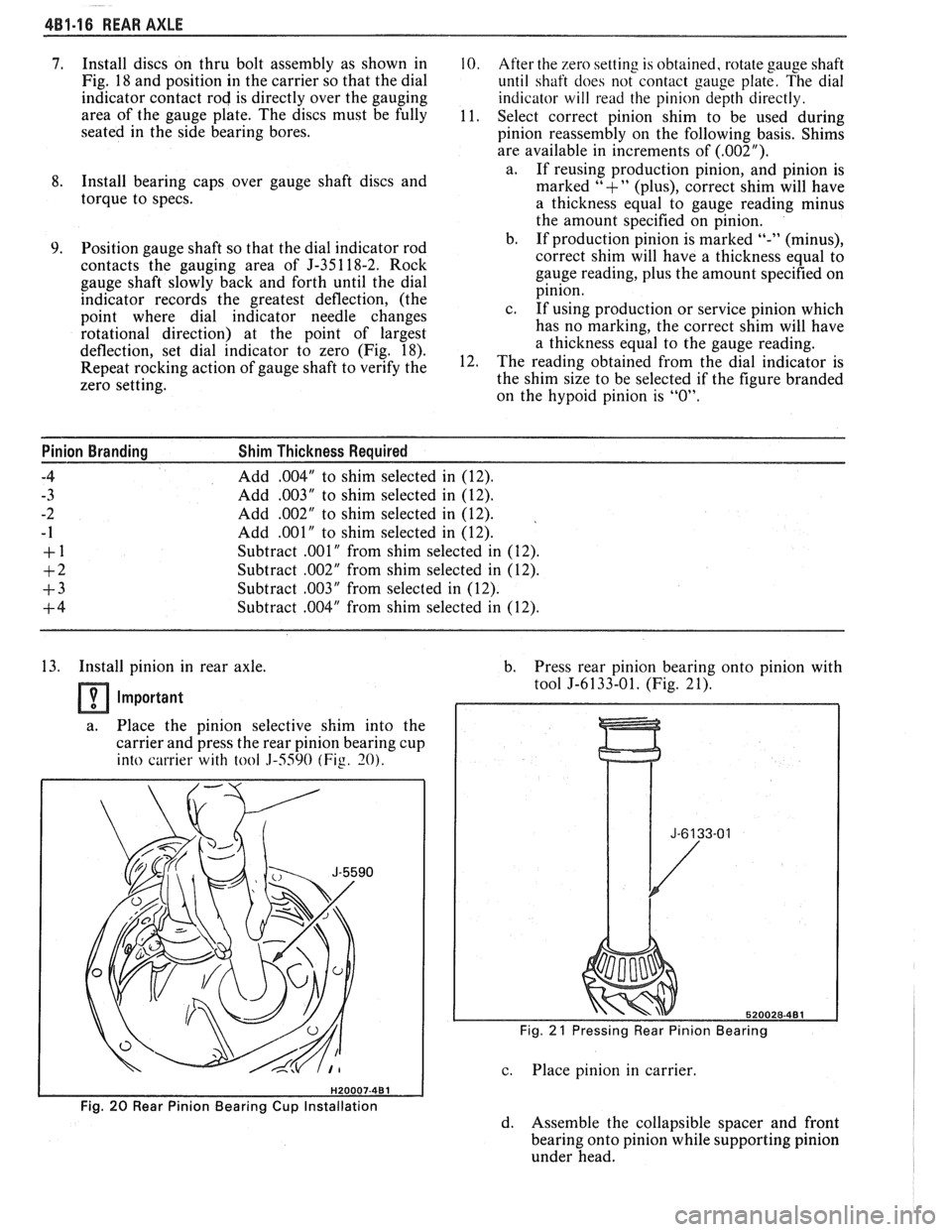
4B1-16 REAR AXLE
7. Install discs on thru bolt assembly as shown in 10. After the zero setting is obtained, rotate gauge shaft
Fig.
18 and position in the carrier so that the dial
until shaft does not contact gauge plate. The dial
indicator contact rod is directly over the gauging
indicator will read the pinion depth directly.
area of the gauge plate. The discs must be fully
11.
Select correct pinion shim to be used during
seated in the side bearing bores.
pinion reassembly on the following basis. Shims
are available in increments of
(.002").
a.
If reusing production pinion, and pinion is 8. Install bearing caps over gauge shaft discs and
marked "+" (plus), correct shim will have
torque to specs.
a thickness equal to gauge reading minus
the amount specified on
ini ion.
Position gauge shaft so that the dial indicator rod
contacts the gauging area of J-35 1 18-2. Rock
gauge shaft slowly back and forth until the dial
indicator records the greatest deflection, (the
point where dial indicator needle changes
rotational direction) at the point of largest
deflection, set dial indicator to zero (Fig. 18).
Repeat rocking action of gauge shaft to verify the
zero setting. b. If production-pinion is marked "-" (minus),
correct shim will have a thickness equal to
gauge reading, plus the amount specified on
pinion.
c. If using production or service pinion which
has no marking, the correct shim will have
a thickness equal to the gauge reading.
The reading obtained from the dial indicator is
the shim size to be selected if the figure branded
on the
hypoid pinion is "0".
Pinion Branding Shim Thickness Required
-4
Add ,004" to shim selected in (12).
- 3 Add ,003" to shim selected in (12).
-2 Add .002" to shim selected in (12).
- 1 Add ,001" to shim selected in (12).
+ 1 Subtract .001" from shim selected in (12).
+2 Subtract .002" from shim selected in (12).
+3 Subtract ,003" from selected in (12).
+4 Subtract ,004" from shim selected in (12).
13. Install pinion in rear axle.
Important
a. Place the pinion selective shim into the
carrier and press the rear pinion bearing cup
into carrier with
tool 3-5590 (Fig. 30).
b. Press rear pinion bearing onto pinion with
tool
5-6133-01. (Fig. 21).
Fig. 21 Pressing Rear Pinion Bearing
c. Place pinion in carrier.
Fig. 20 Rear Pinion Bearing Cup Installation
d. Assemble the collapsible spacer and front
bearing onto pinion while supporting pinion
under head.
Page 270 of 1825
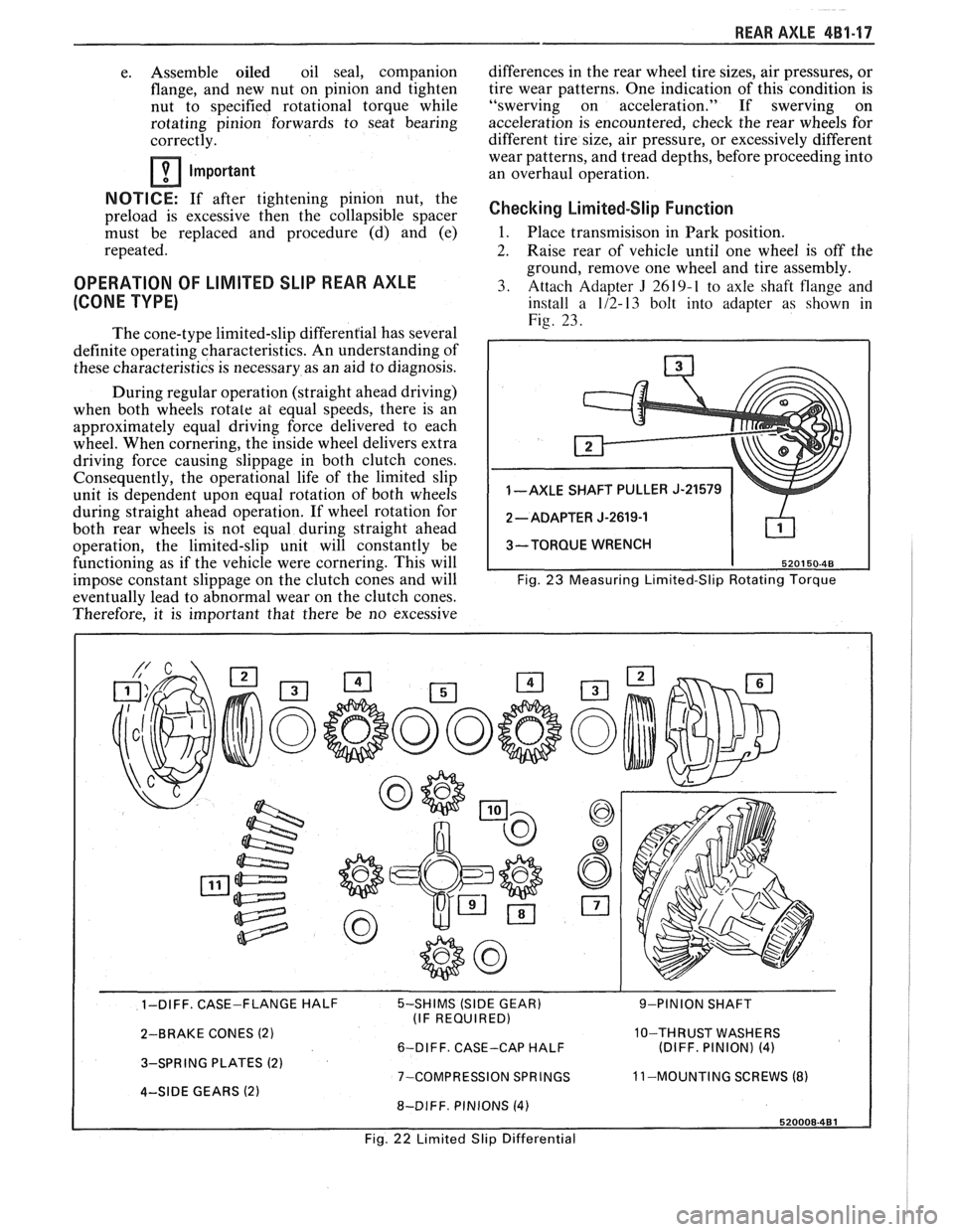
REAR AXLE 4B1-17
e. Assemble oiled oil seal, companion
flange, and new nut on pinion and tighten
nut to specified rotational torque while
rotating pinion forwards to seat bearing
correctly.
Important
NOTICE: If after tightening pinion nut, the
preload is excessive then the collapsible spacer
must be replaced and procedure (d) and (e)
repeated.
OPERATION OF LIMITED SLIP REAR AXLE
(CONE TYPE)
The cone-type limited-slip differential has several
definite operating characteristics. An understanding of
these characteristics is necessary as an aid to diagnosis.
During regular operation (straight ahead driving)
when both wheels rotate at equal speeds, there is an
approximately equal driving force delivered to each
wheel. When cornering, the inside wheel delivers extra
driving force causing slippage in both clutch cones.
Consequently, the operational life of the limited slip
unit is dependent upon equal rotation of both wheels
during straight ahead operation. If wheel rotation for
both rear wheels is not equal during straight ahead
operation, the limited-slip unit will constantly be
functioning as if the vehicle were cornering. This will
impose constant slippage on the clutch cones and will
eventually lead to abnormal wear on the clutch cones.
Therefore, it is important that there be no excessive differences in
the rear wheel tire sizes, air pressures, or
tire wear patterns. One indication of this condition is
"swerving on acceleration." If swerving on
acceleration is encountered, check the rear wheels for
different tire size, air pressure, or excessively different
wear patterns, and tread depths, before proceeding into
an overhaul operation.
Checking Limited-Slip Function
1. Place transmisison in Park position.
2. Raise rear of vehicle until one wheel is off the
ground, remove one wheel and tire assembly.
3. Attach Adapter
J 2619-1 to axle shaft flange and
install a 1/2-13 bolt into adapter as shown in
Fig. 23.
1 -AXLE SHAFT PULLER J-21579
3-TORQUE WRENCH
Fig.
23 Measuring Limited-Slip Rotating Torque
- - 1-DIFF. CASE-FLANGE HALF 5-SHIMS (SIDE GEAR) 9-PINION SHAFT
(IF REQUIRED)
2-BRAKE CONES
(2) 10-THRUST WASHERS
6-DIFF. CASE-CAP HALF (DIFF. PINION) (4)
3-SPRING PLATES (2) 7-COMPRESSION SPRINGS 11
-MOUNTING SCREWS (8) 4-SIDE GEARS (2) 8-DIFF. PINIONS (4)
Fig. 22 Limited Slip Differential